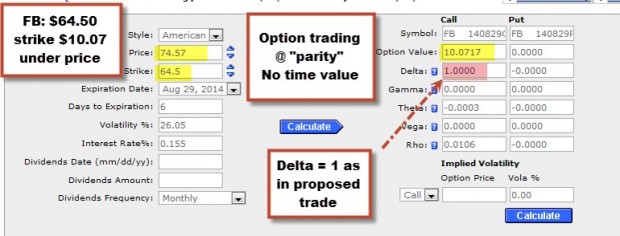Capturing dividends using covered call writing has been a topic on great interest lately. I recently wrote an extensive white paper on this topic located in the “resources/downloads” section of your premium site. In this article I will evaluate an interesting approach to a strategy recently sent to me by one of our members who read it online.
The basis of this game plan is to buy the stock prior to the ex-dividend date (date we must own the shares to be eligible to collect the dividend) and then sell a deep in-the-money call option that is trading with a delta of ”1″ On the ex-date, we now qualify for the dividend and two price changes are expected: both the value of the stock and that of the option drop by the amount of the dividend. These changes are based on the fact that share price does decrease by the amount of the dividend, no argument there. If the option is trading with a delta of “1″ then it, too, should decline by a similar amount. If we then buy back the option at a lower price and sell our shares at a loss, the two positions will cancel each other and now we simply wait to collect the dividend. Finally that free lunch we have been searching for, right? That, ladies and gentlemen, was a rhetorical question.
Here is the example sent to me to demonstrate how this proposed methodology plays out:
- Prior to the ex-date, buy 100 x BCI @ $50.00
- Sell 1 x $40.00 call @ $10.20
- Dividend to be distributed is $1.50 per share
- On the ex-date, share value decreases to $48.50 and option value declines to $8.70 (subtracting $1.50 from both)
- We lose $150.00 in share value and gain $150.00 on the option side for a wash
- Collect $150 on the distribution date
Let’s examine this trade in detail to see if lunch is really free.
What about that $1.50 dividend?
A quarterly dividend of $1.50 annualizes out to $6 or 12% for a $50 security. How many quality stocks generate such a dividend and do we want to get involved with stocks that do? Covered call writing and even dividend capture is a low-risk strategy for conservative investors who emphasize capital preservation.
What about that $40 call option having a time-value component of $0.20?
This would be quite unusual for a quality stock trading so far deep in-the-money such that the option would have a delta of “1″ Instead we would anticipate that option trading at parity or intrinsic value only ($10, in this situation), sometime even with a negative time value. Let’s have a look at Facebook (NASDAQ:FB) trading @ $74.57 with a $64.50 strike, a similar situation to this hypothetical:

Facebook: deep in-the-money option with a delta of “1″
In the yellow-highlighted cells on the left side of the chart we see the difference between the deep in-the-money strike and the stock price is $10.07, similar to the hypothetical trade. In the yellow-highlighted cell on the right side of the chart we see that the option premium is trading at parity which is expected for such a deep in-the-money strike. In the pink cell on the right side, note that the delta is “1′ as proposed in the hypothetical. When there is a time value component to the option premium for a strike $10 in the money for a $70 stock, then the market is anticipating a potential huge price movement by expiration and that is not what covered call writers are looking for…too much risk.
What about commissions?
The proposed trade has four legs and therefore four commissions: buy stock, sell option, buy option, sell stock. Let’s estimate a total debit of $40 for these trades. Now the proposed dividend yield was 12%. Let’s look at a more common 4% yield. For a $50 stock that is $2 annually or $0.50 quarterly which equals $50 per contract. Now deduct the $40 in commissions. Free lunch? We may have to settle for Burger King with a coupon.
Who will actually collect that dividend?
In the proposed trade, the time value component of the option is $20 per contract. If the option is sold, this would be the credit or profit. The proposed dividend is $150. Now here’s another rhetorical question: If you were the option holder, would you exercise the option prior to the ex-date to generate a dividend credit of $150 or sell the option for a credit of $20? Me too. Most option buyers who are taking the other side of our trades also know a little something about dividends and the chance of early exercise is real and probable when the time value of the option is less than the dividend about to be distributed. It is also more likely the closer the ex-date is to the expiration date.
Conclusion
We have to pay for lunch and the best way of affording the meal is to sell traditional covered calls. Now, admittedly, I have written this article a bit tongue-in-cheek but should add that I always respect those who are looking for ways to increase profits with different approaches to our methodology. However, I always advise to look closely at any strategy that appears to be too good to be true because it usually is.
Market tone
US and European stocks rallied on the monthly US employment report after global markets had declined on uncertainty over the UK general election and Greece’s future in the eurozone. US Federal Reserve Chair Janet Yellen’s comments about high valuations also negatively impacted stocks earlier in the week. This week’s reports leaned to the positive:
- The US labor market posted a nonfarm payrolls gain of 223,000 in April
- The unemployment rate fell to 5.4%, the lowest since May 2008
- Hourly wages grew 3 cents to $24.87, up 2.2% from a year earlier
- Initial claims for US unemployment benefits rose 3,000 to 265,000 for the week ended May 2, near a 15-year low. The four-week moving average fell 4,250 to 279,500
- Continuing claims decreased 28,000 to 2.23 million for the week ended 25 April, the lowest reading since November 2000
- The US trade deficit increased to $51.4 billion in March, the largest gap since October 2008
- New orders for US manufactured goods rose 2.1% in March, the biggest increase in eight months
- The Institute for Supply Management nonmanufacturing purchasing managers’ index rose to 57.8 in April from 56.6 in March
- The service sector PMI slipped to 57.8 from a f March reading of 59.2.
- First-quarter US nonfarm productivity fell by 1.9% annually, following a 2.1% decline in the fourth quarter, making this the first back-to-back quarterly decline since 2006.
For the week, the S&P 500 rose a fraction of 1% for a year to date return of 2.8%.
Summary
IBD: Market in correction
GMI: 1/6- Sell signal since market close of May 7, 2015 (before Friday’s rally)
BCI: Cautiously bullish and using an equal number of in-the-money and out-of-the money strikes. The triple digit moves in the market are still unsettling although the late week rebound was admittedly impressive. I remain bullish but defensive.
